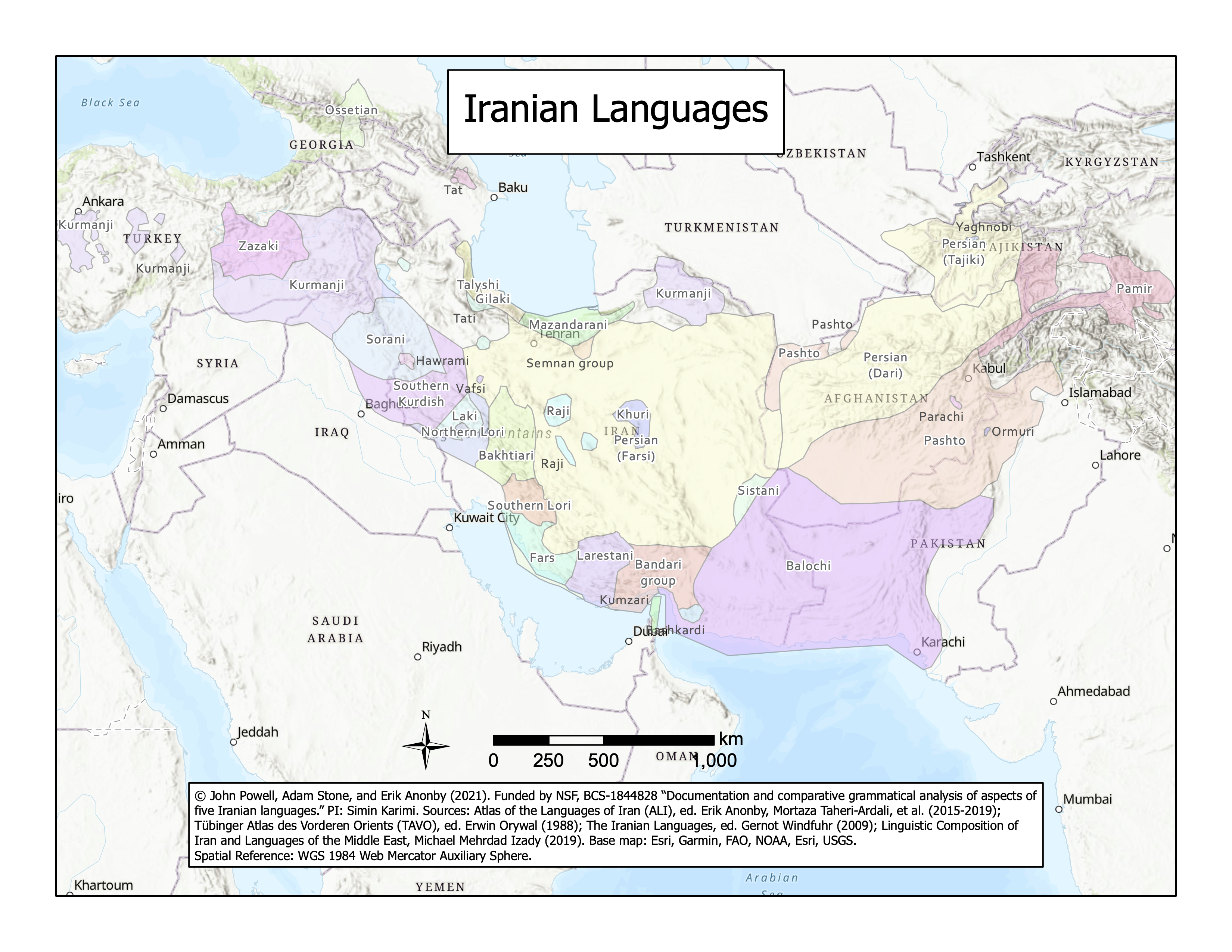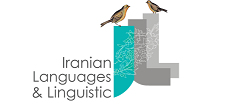
The Iranian language family is a family of languages spoken in the regions as shown in the map above. The oldest attested languages in the family are Old Persian, known from the cuneiform inscriptions of the Achaemenian emperors, and Avestan, the language of Avesta, a collection of sacred Zoroastrian texts. Old Persian can be clearly associated with the Southwest Iranian group, and must be considered a direct precursor of Middle and Modern Persian (Payne 1990). The three major variants of Persian are: Farsi (Iran), Tajiki (Tajikistan), and Dari (Afghanistan). However, the family also consists of languages in other regions, and can be classified as below.
Branches of the Iranian Language Family
Southwestern
- Persian
- Farsi in Iran,
- Tajiki in Takikistan
- Dari in Afghanistan
- Lori, spoken in Loristan and Ilam, two provinces in Western Iran
Northwestern
- Kurdish language family
- Kurmanji, spoken in the northern part of Kurdistan province in Iran, and in Iraq, Syria, and Turkey
- Sorani, in the Kurdish areas across the border of Iran and Iraq
- Gorani-Zazaki group
- Gorani or Hawrami in southern part of Kurdistan
- Zazaki (or Dimli) in Anatolia (Turkey)
- Laki, in the western part of Iran
- Balochi, in the eastern part of Iran and Pakistan
- Taleshi, along the Caspian Sea in Iran
- Mazandarani and Gilaki, near the Caspian Sea
- Vafsi, in the central areas in Iran
Southeastern
- Pashto, spoken in Pakistan and Afghanistan
- Pamiri, spoken in Central Asia
Northeastern
- Ossetian, spoken in Russia and Georgia
Language Currently Being Studied
The Iranian Linguistics Research Team has been able to study many (but not all) of these languages utilizing money from the NSF grants awarded to Simin Karimi (PI), Heidi Harley, and Mike Hammond (Co-PIs). The current NSF grant is dedicated towards writing a comparative grammar for five Iranian languages: Balochi, Ossetian, Pashto, Persian, and Sorani (map included below). An overview of these languages is provided below the map.
Overview of Linguistic Characteristics
All Iranian languages exhibit some common characteristics. One such property is that they are all verb-final and null subject. Other common properties include (a) the remarkably rich and interesting complex predicate constructions (b) the existence of a broad range of aspectual, directional and inflectional affixes, and (c) various degrees of scrambling. The western branch exhibits a morpho-syntactic phenomenon called EZAFE construction where an EZAFE enclitic links a nominal element to its modifiers and possessor. The literal meaning of EZAFE is ‘addition’.
There are also some differences between these languages. For example, some of these languages have nominative/accusative properties (Persian, Ossetian), while most of them have retained various versions of split-ergativity in transitive constructions in past tense (Sorani, Pashto). Furthermore, while Persian passive construction seems to be overwhelmingly morphological (Folli, Harley, Karimi 2005), other Iranian languages exhibit mixed constructions consisting of both morphological and structural patterns. Moreover, some of the Iranian languages, Sorani, Ossetian and Pashto specifically, exhibit interesting complex behavior with respect to clitic placement that are not shared by other languages in this family. Yet another difference between these languages is object marking. While some of them, e.g. Persian, marks specific objects, known as Differential Object Marking (DOM) (Karimi 1990, 1996, Karimi & Smith 2018, Ghomeshi 1997, Jasbi 2018, among others), others lack this property. Although all Iranian languages have rich complex predicate constructions, they vary in terms of the number of light verbs and the types of non-verbal elements. Ossetian, for example, has only two light verbs and its non-verbal elements ranges over nominals and adjectives. Persian, on the other hand, has about twenty light verbs and a rich set of non-verbal elements including nominals, adjectives, prepositional phrases and particles. Plural marking is fairly simple in some languages (e.g. Ossetian) and extremely complex exhibiting various patterns (e.g. Pashto). Some of the modern Iranian languages do not make gender distinctions in any category (Persian), while some display rich patterns in this regard (Pashto). Finally, elliptical constructions receive various acceptability levels in these languages.
As for phonology, these languages share a large portion of their sound inventories. Most languages utilize the labial, dental, alveolar, postalveolar, and glottal places of articulation. Some also include a uvular series of stops or fricatives (Pashto, Persian, Ossetian). Several languages feature unique sounds for the language family, including a retroflex series in Pashto and Balochi, and an ejective series in Ossetian.
The syllable structure of these languages varies. Some require onsets (Persian, Sorani), while others exhibit relatively free syllable structure including a wide diversity of possible consonant clusters (Pashto). Most languages feature reversed sonority clusters word initially and finally, likely due to language contact with Arabic and each other. However, reversed sonority clusters are handled in a variety of ways including vowel insertion (Balochi, Pashto) and word final devoicing (Persian).
Stress is also variable between languages. Ossetian features on onset sensitive stress system while Persian and Balochi feature fixed stress systems (ultimate & penultimate respectively). Pashto has lexically defined stress. All languages feature interactions between morphology, syntax, and stress placement. All feature clitics and/or preverbal elements that are necessarily stressed. This may lead to a unified accent based analysis among all languages.
The variations among these languages can be attributed, in part, to areal influences. This includes strong Arabic influences on Persian and Sorani Kurdish (reversed sonority clusters) while Pashto is more influenced by Hindi and Urdu (retroflex consonant series). Ossetian also shows strong influences from Russian and Georgian due to its location (borrowings).
We describe in more detail the features specific to each language in the individual language's tab.

